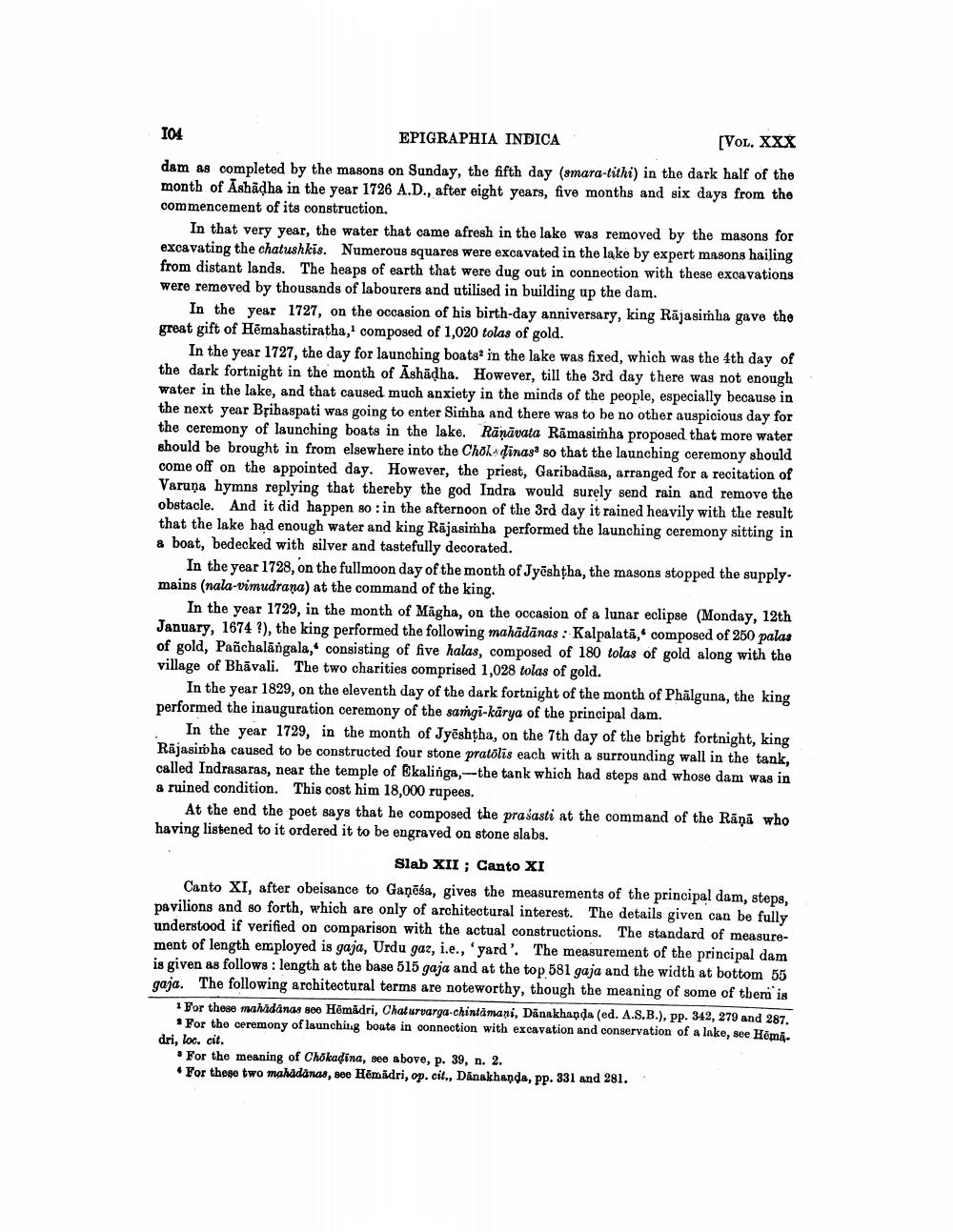________________
104 EPIGRAPHIA INDICA
[VOL. XXX dam as completed by the masons on Sunday, the fifth day (amara-tithi) in the dark half of the month of Ashädha in the year 1726 A.D., after eight years, five months and six days from the commencement of its construction,
In that very year, the water that came afresh in the lake was removed by the masons for excavating the chatushkis. Numerous squares were excavated in the lake by expert masons hailing from distant lands. The heaps of earth that were dug out in connection with these excavations were removed by thousands of labourers and utilised in building up the dam.
In the year 1727, on the occasion of his birth-day anniversary, king Räjasimha gave the great gift of Hēmahastiratha, composed of 1,020 tolas of gold.
In the year 1727, the day for launching boats in the lake was fixed, which was the 4th day of the dark fortnight in the month of Ashādha. However, till the 3rd day there was not enough water in the lake, and that caused much anxiety in the minds of the people, especially because in the next year Bțihaspati was going to enter Simha and there was to be no other auspicious day for the ceremony of launching boats in the lake. Rāṇāvata Rămasimha proposed that more water should be brought in from elsewhere into the Chok dinas: so that the launching ceremony should come off on the appointed day. However, the priest, Garibadāsa, arranged for a recitation of Varuņa hymns replying that thereby the god Indra would surely send rain and remove the obstacle. And it did happen so : in the afternoon of the 3rd day it rained heavily with the result that the lake had enough water and king Rājasimha performed the launching ceremony sitting in a boat, bedecked with silver and tastefully decorated.
In the year 1728, on the fullmoon day of the month of Jyēshtha, the masons stopped the supply. mains (nala-vimudrana) at the command of the king.
In the year 1729, in the month of Māgha, on the occasion of a lunar eclipse (Monday, 12th January, 1674 ?), the king performed the following mahādānas : Kalpalată, composed of 250 palas of gold, Panchalāngala, consisting of five halas, composed of 180 tolas of gold along with the village of Bhāvali. The two charities comprised 1,028 tolas of gold.
In the year 1829, on the eleventh day of the dark fortnight of the month of Phälguna, the king performed the inauguration ceremony of the sangi-karya of the principal dam.
In the year 1729, in the month of Jyēshtha, on the 7th day of the bright fortnight, king Rājasiroha caused to be constructed four stone pratölis each with a surrounding wall in the tank, called Indrasaras, near the temple of Ekalinga,--the tank which had steps and whose dam was in a ruined condition. This cost him 18,000 rupees.
At the end the poet says that he composed the praśasti at the command of the Rāņā who having listened to it ordered it to be engraved on stone slabs.
Slab XII; Canto XI Canto XI, after obeisance to Gaņēša, gives the measurements of the principal dam, steps, pavilions and so forth, which are only of architectural interest. The details given can be fully understood if verified on comparison with the actual constructions. The standard of measurement of length employed is gaja, Urdu gaz, i.e., 'yard'. The measurement of the principal dam is given as follows: length at the base 515 gaja and at the top 581 gaja and the width at bottom 55 gaja. The following architectural terms are noteworthy, though the meaning of some of them is
1 For these mahidanas 800 Hómadri, Chaturvarga-chintamani, Danakhanda (ed. A.S.B.), pp. 342, 279 and 287.
For the ceremony of launching bouta in connection with excavation and conservation of a lake, see Héma. dri, loc. cit.
. For the meaning of Chokadina, see above, p. 39, n. 2. . For these two mahadanas, see Hemadri, op. cit., Danakhanda, pp. 331 and 281..




